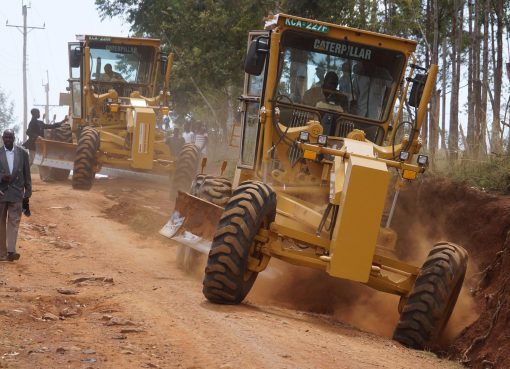Major infrastructural developments continue to catapult the Ports of Mombasa, Lamu, and Kisumu to efficiency.
The Port of Mombasa recorded a remarkable increase in cargo throughput from January to September 2024, handling a total of 29.92 million tonnes compared to 26.68 million tonnes registered during the same period in 2023.
This marks a significant growth of 3.23 million tonnes, or 12.1 per cent, showcasing the port’s resilience and capacity to handle increasing trade volumes.

In terms of container traffic, the Port processed 1,461,736 Twenty-foot Equivalent Units (TEUs) during the period under review, a substantial increase from the 1,191,282 TEUs handled in 2023, reflecting growth of 270,454 TEUs, or 22.7 per cent.
Transshipment traffic exhibited exceptional growth, registering an increase of 216,339 TEUs, or 162.8 per cent. Both imports and exports also demonstrated moderate growth, with imports rising by 27,656 TEUs (5.2 per cent) and exports increasing by 22,273 TEUs (4.3 per cent).
Transit cargo saw significant improvement as well, with total transit volumes reaching 9.83 million tonnes compared to 8.36 million tonnes in 2023, a variance of 1,469,540 tonnes, or 17.6 per cent. Uganda played a pivotal role in this upturn performance, contributing to an increase of 1,132,326 tonnes, or 21.9 per cent.
The Kenya Port Authority (KPA) has introduced 24-hour service delivery to its customers, streamlined cargo clearing services, upgrades of major equipment, digitisation, and investment in human resources.
“Continuous expansion, building capacity before the demand. Over the years, we have continued expanding through the Mombasa Port Development Project,” says KPA Managing Director Capt. William Ruto.
The project has three phases; phase one was completed in 2017; it increased the Port of Mombasa capacity to 550,000 TEUs.
Phase two saw the construction of berth 22. It has added a throughput capacity of 450,000 TEUs.
“This Port has an annual throughput capacity of 2.2 million TEUs, not forgetting the private sector, which has invested in Container Freight Stations (CFSs), which we consider as an extension of the Port,” stated Capt. Ruto.
The SGR connected to KPA’s Inland Container Depots in Nairobi and Naivasha has assisted KPA in enhancing service delivery to customers.
The MD termed the Shimoni Port as a catalyst in the exploitation of the Blue Economy. KPA is providing infrastructure to facilitate cold storage facilities and processing for export and Value Addition.
“We have modernised that port to facilitate better access to both local and international markets, which will also attract foreign and domestic investment in the fishing markets and increase the country’s fish products competitiveness,” explained Capt. Ruto.
Transit countries like Uganda are now able to receive petroleum products in a short time through the Port of Kisumu.
“Through the oil jetty in Kisumu, petroleum products are now pumped directly from here to Kisumu through a pipeline. From Kisumu, Uganda has invested in a vessel that can carry about four million litres in one trip,” said Capt. Ruto.
This means, he added, we can now remove more than 160 trucks from the road, reducing road damage, creating safety, and reducing carbon emissions along the corridor.
The infrastructure investments by KPA have also reduced the cost of doing business. The Port is now able to handle three vessels in a week. About 12 million litres of petroleum products are transported through Lake Victoria.
“As KPA, we are now offering three intermodal transportations for our customers: we are connected with Metre Gauge Railway from here to Kisumu, and from Kisumu you can load using the waggons.”
The Port of Lamu has been positioned to be a transshipment hub and to handle cargo destined for the Southern part of Ethiopia and South Sudan. The Port of Lamu complements the Port of Mombasa.
The installation of the state-of-the-art Super Post Panamax Ship-to-Shore (STS) gantry cranes and rubber tyre gantry cranes has enabled the Port of Mombasa to handle bigger vessels of up to 10,000 TEUs capacity.
“Port of Lamu is one of the deepest ports in Africa. It can handle up to 80,000 TEUs Capacity ship or minus 17. The only other Port in Africa which can compete with the Port of Lamu is the Port of Tanger Med in Morocco,” stated the MD. “In terms of competitive edge, KPA is on the right trajectory.”
KPA has also invested in reefer points in Nairobi, Naivasha, and Mombasa to support the exportation of perishable agricultural produce.
The Authority has also invested in the development of the Homa Bay pier to replace the old infrastructure that was submerged. The Authority has also procured one ferry to assist people living in Homa Bay Islands.
“KPA aims to transform this port into a globally competitive hub that can compete with other international ports. We will continue to invest in infrastructure, technology, and operational efficiency, which will position the Ports of Mombasa and Lamu into regional maritime hubs.”
Kenya International Freight and Warehousing Association (KIFWA) Executive Officer Wycliffe Wanda lauded KPA for improving port efficiency evident in container clearance and truck turnaround.
Wanda said the Ports and Nairobi ICD efficiencies have reduced the cost of doing business.
By Sadik Hassan and Mariam Sefu




